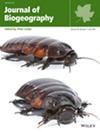Climate-Driven Vegetation Characteristics Shape Phytophagous and Carnivorous Insect Diversity in South African Savannahs
Abstract
Aim
Despite the evidenced importance of insects in savannah ecosystems, the drivers of their diversity patterns remain poorly understood, particularly in the Afrotropical region. This study addresses part of this gap by investigating the effects of climate, habitat, disturbance and vegetation variables on species richness and community composition of phytophagous and predatory insects in South African savannahs.
Location
Kruger National Park (KNP), South Africa.
Taxon
Phytophagous insects (moths) and carnivorous insects (mantises).
Methods
Moths and mantises were light-trapped in 60 plots distributed across KNP during two seasons. Direct and indirect effects of environmental variables on insect species richness were analysed using structural equation models, and on community composition through distance-based redundancy analyses (db-RDA).
Results
Based on an extensive dataset of 65,593 moth individuals representing 817 species and 3511 mantis individuals representing 38 species, we identified plant communities as the primary driver of species richness and community structure for both insect groups. The effects of vegetation on insect communities were indirectly shaped by climate, particularly mean temperature (negatively correlated with precipitation), through its effects on plant species richness. Additionally, a complex interplay among bedrock type, water availability and disturbance from large herbivores further shaped insect diversity.
Main Conclusions
Our findings highlight the critical role of plant species richness in determining insect diversity patterns in savannah ecosystems. We also confirmed the region's vulnerability to climate change, as decreasing precipitation and increasing temperatures alter vegetation composition and biomass, consequently affecting insect communities. Effective conservation strategies should focus on managing large herbivores to maintain diverse vegetation, which is crucial for supporting insect diversity. Priority should be given to balancing water availability and disturbance intensity, particularly in preserving the health of rivers and their surroundings, to mitigate the adverse effects of climate change on these ecosystems.

 求助内容:
求助内容: 应助结果提醒方式:
应助结果提醒方式:


